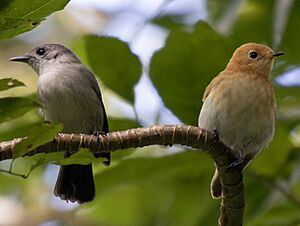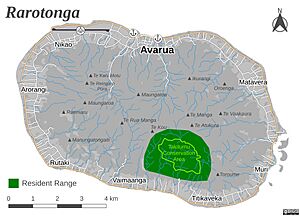Rarotonga monarch facts for kids
Quick facts for kids Rarotonga monarch |
|
|---|---|
 |
|
| Left: Grey Rarotonga monarch, at least 4 years old. Right: Orange Rarotonga monarch with yellow in its beak, under 1 year old. The plumage colouration is age dependant, not sexually dimorphic. | |
 |
|
| Conservation status | |
| Scientific classification | |
| Genus: |
Pomarea
|
| Species: |
dimidiata
|
 |
|
| The resident range within Rarotonga. An introduced range also exists on Atiu island.
Resident range Introduced range |
|
 |
|
| Synonyms | |
|
|
The Rarotonga monarch (Pomarea dimidiata), also called the Rarotonga flycatcher or Kākerōri, is a type of bird. It belongs to the monarch flycatcher family, Monarchidae. This bird is special because it is only found naturally on Rarotonga, Cook Islands. Some of these birds have also been moved to Atiu, Cook Islands.
Contents
About the Rarotonga Monarch
The Rarotonga monarch was first described in 1871. People sometimes call it the Cook Island flycatcher or Cook Islands monarch. Its local name is Kakerori.
What Does the Kakerori Look Like?
The Rarotonga monarch is a small bird that eats insects. It stands about 10 centimeters (4 inches) tall. Adult female birds weigh around 20 grams (0.7 ounces). Larger male birds can weigh about 25 grams (0.9 ounces). These birds mostly find insects in leaves. They also catch insects while flying.
The Rarotonga monarch has unusual feather colors. It is the only bird known to change its feather colors as it grows older. At first, people thought the grey and orange birds were different species. Later, they thought grey birds were males and orange birds were females or young ones. But in 1983, scientists learned that the colors depend on the bird's age. Young birds are orange or orange-grey. They become completely grey when they are about four years old. This grey color stays for the rest of their lives.
Kakerori Behavior and Life Cycle
Because it lives on a tropical island, the Rarotonga monarch lives a very long time. Adult birds have a high chance of surviving each year, between 85% and 89%. They usually live for seven to nine years. The oldest known Kakerori lived for almost 25 years! This is much longer than many other small songbirds.
How Rarotonga Monarchs Reproduce
The long lifespan of these birds might explain why they have "helpers at the nest." This means other birds, often young males, help the parents raise their chicks. This is rare in their bird family. Male birds can start breeding at one year old. However, they usually wait until they are four years old.
The breeding season is from October to February. Most eggs are laid in October and early November. The nests are deep cups made of moss. They are built in the fork of a tree branch, often above creeks. It takes about 14 days to build a nest. A female usually lays one or two eggs.
Threats to the Kakerori Birds
In Rarotonga, many nests fail because of black rats or kiore (Pacific rats). These rats eat the eggs or young birds. When black rats and feral cats were brought to the island, the number of adult birds that died more than doubled. This made the Rarotonga monarch one of the most endangered birds in the world by the mid-1980s.
To help the birds, people started removing rats every year. This happens before the breeding season in the Takitumu Conservation Area. This project has made breeding much more successful. Now, about two-thirds of pairs can successfully raise two eggs. In the 1980s, only about 11% of breeding attempts worked. Even with this success, a big tropical cyclone could quickly harm the population. So, conservation work is still very important.
Kakerori Conservation Status
In 1989, there were fewer than 29 Rarotonga monarchs left in the wild. They were considered critically endangered. But thanks to yearly rat baiting during the breeding season, their numbers have grown.
The Rarotonga monarch used to be found only on Rarotonga. But in 2001, 30 young birds were moved to Atiu Island. This created a second population. This "insurance population" helps protect the species if something bad happens on Rarotonga.
In 2022, the total population was estimated at 500 mature birds. The Rarotonga monarch is now considered a vulnerable species. This recovery is a big success story for bird conservation in the South Pacific. The Takitumu Conservation Area project even won a Conservation Award from Birdlife International in 2022.



